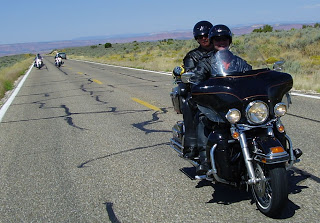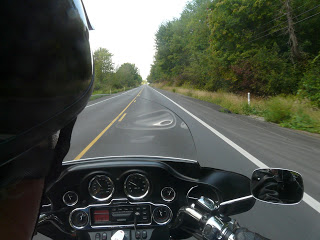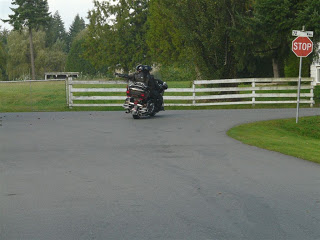Co-Rider – No Longer Just the Passenger

Before we were married, my husband and I worked together in a job where lives depended on teamwork. Reading and anticipating each other became second nature. Riding together on the same motorcycle was a natural extension of that way of thinking, making the whole experience safer and more enjoyable. We believe that we each share the responsibility for getting ourselves safely down the road as rider and co-rider, not rider and passenger. After more than 100,000 miles—not completely without incident—I still believe we have a winning formula.
Sometimes couples seem as though their ride has been choreographed, moving seamlessly. Typically, they’re communicating the whole time. Communication doesn’t require an intercom; nudging, pointing, nodding, key words, (“Bambi!” = deer, moose, caribou…goats) all qualify if they are mutually understood. One-way communication is not communication.

If the person on the back understands what is required, she, or sometimes he, can contribute appropriately. Unfortunately some first-time passengers are told to “sit down, shut up and hang on”. This is a poor way of preparing someone prior to a ride and may be an indicator of that rider’s ability. If you hear this, consider staying home. On the other hand when a rider advises his “second seater” of such things as what to do when cornering, when braking, how and when to get on and off and what to watch for, the ride is far more enjoyable. Once you’re both in the same page, you become a rider/co-rider team.
Our ride starts before the ride. We both agree on the route, so I can anticipate turns, and of course we both understand when one suggests a change enroute. I spot for him as he backs the bike up—watching for sand on pavement, small stones or large cars. Getting on is an art in itself; I cringe when I see a rider struggle when the passenger doesn’t keep their weight close to the centre line of the bike. Holding up several hundred pounds can be tough enough without being pulled or pushed sideways. I don’t get on until I get “the nod”– and he doesn’t go until he gets “the double pat”.

We have been complimented on how smooth we look when we ride. To achieve that, we contradict most riders’ training. Often in training, riders are told to have their passengers look over the same shoulder as the direction of the turn. On the other hand the rider is also trained in various ways to keep his or her weight close to the centre line of the bike during normal cornering. Unless very disciplined, looking over the rider’s inside shoulder can cause the passenger’s body to lean into the turn excessively, forcing the rider to compensate for something he or she is not prepared for. Worse, that inside lean is often inconsistent, making it difficult for the rider to anticipate from one turn to another. I consistently follow my husband’s moves exactly, trying not to provide any input either way. In “technical” situations (read: lots of tight turns), I also lean forward slightly, keeping the weight slightly forward on the motorcycle. This also has the tendency to keep me from flopping out of sync with the turns. However you choose to engage a corner, be together on the method and be consistent. The result will be smooth, predictable, fun cornering.

Compensating for braking is possibly the most important action a co rider can take. During braking, weight is transferred onto the front wheel and off of the rear wheel, giving it less traction. Managing this loss of rear-wheel traction is a large part of braking. If passengers are unprepared —especially during emergency braking—two things happen.
First, they physically move forward, compounding the problem of weight transfer forward. Second, their weight falls on the rider, who is already busy enough maintaining their own position during a dynamic braking situation. In this case, the passenger’s inaction can contribute greatly to a crash. We have had different motorcycles, each one having some means for me to hold myself from shifting forward during braking. A strap across the saddle in front of the passenger won’t stop upper body motion at all, whereas grabbing the backrest bracket or rigid handles at the side will. I rest my hands nearby to use them in addition to using the boards or pegs to control my forward motion. Being prepared has definitely paid off on a couple of notable occasions. An added plus; handholds are nice to have in severe wind.
We have followed bikes where the passenger is bounding around to sightsee, get more comfortable, take pictures or get things from their pack. If you wouldn’t stand in a canoe, why would you dance on a bike? Sudden and erratic movements have a significant impact on the rider’s ability to control the bike, especially in corners. All of those things can be accomplished with no impact if done in the right way at the right time.
I adjust my butt when we shift or go over bumps and otherwise move smoothly and slowly. Leg-stretching is saved for when we are at a stop, and even then I let him know what I’m going to do. Another added plus; a less-fatigued rider is a lot more fun during happy hour at the end of the day.
Co-riding is an active, not a passive role, but at the same time it is not “back seat riding.” The rider has a job to do and your role is to complement his or her actions, not complicate them. For his part, my husband shares his knowledge of riding techniques and is very mindful of my needs and comfort. You are an extra set of eyes and ears, able to see and hear things that the rider cannot. Your life is in the rider’s hands and the rider’s in yours, so you have equal responsibility for the outcome. Now that’s sharing the ride.
As our friends have said, we ride as one and so can you.

This article was originally published in Canadian Biker Magazine – Jan/Feb 2009 issue #248. Check out their site at: Canadian Biker Magazine
